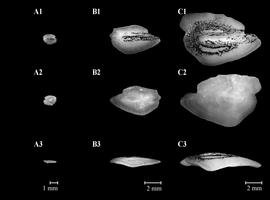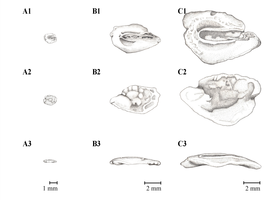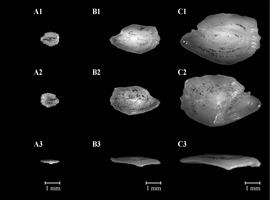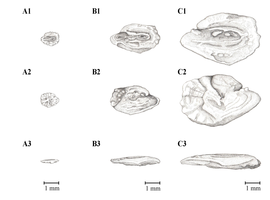Paralichthys patagonicus Jordan, 1889
(Paralichthyidae, Pleuronectiformes)
The collection contains otoliths from 138 individuals of this species, ranging from 91 to 555 mm of total length. Click here to see the map of the sampling area for the individuals of this species. The following summaries contains data from 190 analysed otoliths. See more detailed data here (in portuguese).


Right otolith


Otoliths from Paralichthys patagonicus, with total length of A. 125mm; B. 323mm; C. 555mm; internal side A1; B1; C1; external side A2; B2; C2; profile of the ventral region A3; B3; C3; click the figures for larger version*
Morphology:
Shape: elliptic (74%), oval (26%). Anterior region: peaked-round (77%), peaked (13%), rounded (9%), double-peaked (1%). Posterior region: rounded (82%), flattened (18%). Dorsal edge: sinuate (79%), lobed (13%), entire (8%). Ventral edge: sinuate (47%), entire (39%), lobed (13%), lobed to sinuate (1%). Profile: concave-convex (92%), biconvex (6%), flattened (2%). Rostrum and antirostrum orientation: not applicable. Rostrum: Developed (99%), absent (1%). Antirostrum: absent. Pseudorostrum: absent. Pseudoantirostrum: absent. Sulcus acusticus: position median, orientation horizontal (98%), ascending (2%), opening ostial (66%), para-ostial (34%), morphology heterosulcoid, colliculum heteromorphic, ostium elliptic (93%), funnel-like (7%), cauda round-oval.
Description of the terms used
Morphometry:
| Shape indices | Mean ± sd | Minimum | Maximum |
|---|---|---|---|
| OL / TL % | 2.21 ± 0.15 | 1.93 | 2.61 |
| OH / OL % | 66.42 ± 4.68 | 57.52 | 78.57 |
| OT / OL % | 18.26 ± 1.67 | 14.35 | 21.75 |
| OT / OH % | 27.53 ± 2.1 | 20.71 | 32.57 |
| Circularity | 16.45 ± 1.41 | 14.71 | 22.59 |
| Rectangularity | 0.70 ± 0.02 | 0.64 | 0.79 |
Morphology:
Shape: elliptic (73%), oval (27%). Anterior region: peaked-round (77%), peaked (14%), rounded (8%), angled (1%). Posterior region: rounded (88%), flattened (11%), oblique (1%). Dorsal edge: sinuate (62%), entire (25%), lobed (13%). Ventral edge: entire (51%), sinuate (38%), lobed (12%). Profile: concave-convex (98%), biconvex (2%). Rostrum and antirostrum orientation: not applicable (89%), in agreement (11%). Rostrum: Developed (99%), absent (1%). Antirostrum: absent (88%), underdeveloped (8%), Developed (3%). Pseudorostrum: absent. Pseudoantirostrum: absent. Sulcus acusticus: position median, orientation horizontal (99%), ascending (1%), opening ostial (67%), para-ostial (33%), morphology heterosulcoid, colliculum heteromorphic, ostium elliptic (92%), funnel-like (8%), cauda round-oval.
Description of the terms used
Morphometry:
| Shape indices | Mean ± sd | Minimum | Maximum |
|---|---|---|---|
| OL / TL % | 2.10 ± 0.13 | 1.71 | 2.43 |
| OH / OL % | 65.25 ± 5.27 | 47.21 | 93.97 |
| OT / OL % | 21.23 ± 2.91 | 14.38 | 27.80 |
| OT / OH % | 32.63 ± 4.57 | 22.30 | 47.64 |
| Circularity | 16.33 ± 1.37 | 14.39 | 21.37 |
| Rectangularity | 0.70 ± 0.05 | 0.63 | 0.98 |
* Vouchers:
Collection identifier for the individuals shown on photography and drawings:
- 26.2.PAPAT.PI.AF.18.3 (125 mm)
- 26.2.PAPAT.PI.AF.11.5 (323 mm)
- 26.2.PAPAT.PI.AF.11.1 (555 mm)
For more information about this species:





